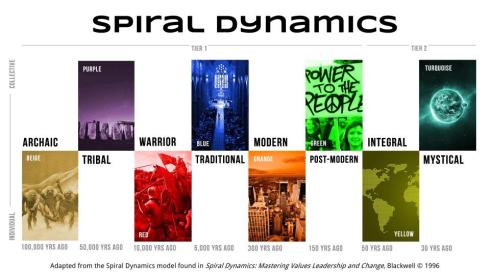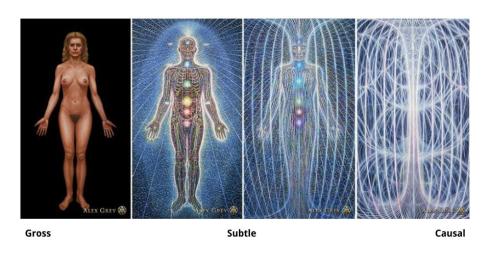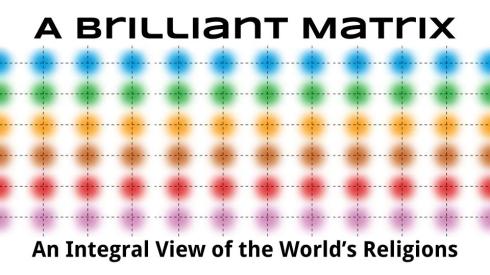Game of Thrones is a sprawling violent, bloody snapshot of a medieval fantasy world where different kingdoms and bloodlines struggle for control of the much-coveted “Iron Throne” — a seat in the capitol that rules all Seven Kingdoms of Westeros.
It’s also a detailed glimpse into a fictional world in spiritual transition — from ancestral nature religions to a mythical/numerological polytheism to an emerging (and much-contested) monotheism. If you watch Game of Thrones, you’ll notice that there is a lot of time spent explaining the religious motivations of the characters. It’s as if religion itself is a character in the story. The characters may offer “seven blessings” to their loved ones or curse their enemies to the “seven hells” — the number seven representing a set of archetypes based on social and spiritual virtues (Father, Mother, Warrior, Maiden, Smith, Crone, Stranger). At the same time, some characters are bent on appeasing the “one, true God” — the nascent and wrathful “Lord of Light” — through the blood and fire of human sacrifice.
Throughout the story, what the characters believe and how they interact with and interpret the actions of others begins to change based on what they begin to see with their own eyes. And to hear this kind of religion described, you might think that these forms of worship, these outdated modes of spiritual expression, so rooted in mythology and superstition, have long passed from our society. I can assure you, that in some corners of our planet, these types of nature-based and/or polytheistic religion (or variations of them) are still very much alive.
“Integral” Spirituality is part of a lineage that is woven through many teachers (Sri Aurobindo, Haridas Chaudhuri, Alan Watts, Ken Wilber, et. al.). And very recently, religion (or the interpretation of religious experience) that is rooted in post-modern and pluralistic structures has done much to synthesize some of our more sacred and socially held values that have long been viewed as opposites — ideas like east and west, science and spirituality, inner and outer, masculine and feminine, the individual and the collective, grasping and sitting — it is an emerging spirituality, not of either/or, but of both/and.
However, it’s not all rose-colored radical inclusivity. Implementing pluralism as its own practice, while avoiding the accusations and actual pitfalls of syncretism has proven to be difficult. Integral spirituality needs to honor the differences we find in the various religions and it does so not by comparing the human experience of gods and goddesses to the experience of blind men with an elephant, or minimizing the paths of tradition by winding them up the same mountain of “spiritual Oneness.” It succeeds by making a clear distinction between things like cultural history, creativity and mythology, human rights and freedoms, communities of practice, states of awareness, stages of consciousness, lines of development or intelligence, personality and gender types, and so on.
We will look at two of those here — stages and states — and hopefully gain a better understanding of how Integral spirituality allows us a deeper and more meaningful understanding of the relationship with our Self, with those around us and with the Divine, or Spirit-in-Action.
Stages of Consciousness
First we’ll look at stages of consciousness. These stages have been imagined as a vertical line (or nested hierarchy of circles).
This is how cultures have mapped the development or unfolding of our own worldview as we move from birth to death. These stages, according to Ken Wilber’s A Brief History of Everything, move us from egocentric (care and concern for the self) to ethnocentric (care and concern for the family or the community) to worldcentric (care and concern for all beings).
It’s best illustrated with something called Spiral Dynamics. Developed by Don Beck and Chris Cowan, this model proposes the idea that the consciousness of all beings (as well as all societies or groups) unfolds in a spiral that oscillates between self-interest and concern for the group, and is continually expanding while incrementally including more and more perspectives.
| VALUES SYSTEM | COLOR | DESCRIPTION |
| Archaic | Beige | Primal, instinctive, survivalistic. Food, warmth, sex and safety.
Origin: 100,000 years ago. |
| Tribal | Purple | Loyalty to the tribe, magical/animistic beliefs, family rituals and blood oaths. Observe customs and cycles. Sacrifice is made for the tribe.
Origin: 50,000 years ago. |
| Warrior | Red | Impulsive/egocentric beliefs, self-interest, self-expression, only the strong survive, domination and rebellion, kingdoms and heroes (negatives: gangs, the “terrible twos”). Creates change through the use of power.
Origin: 10,000 years ago. |
| Traditional | Blue | Authoritarian beliefs, law and order, good and evil polarized, mythic/literal interpretations, ethnocentric, “my country right or wrong.” (positives: ordered meaningful existence, absolute truth, rightful living). Sacrifice is made for truth.
Origin: 5,000 years ago. |
| Modern | Orange | Self-reliance, rational/scientific worldview, achieveist/strategic beliefs, “life is a game,” risk-taking. (positive: the Enlightenment, industrial revolution, negative: capitalist exploitation, environmental devastation, mechanistic view of life/the universe). Creates change through manipulation.
Origin: 300 years ago. |
| Post-modern | Green | Communitarian/egalitarian, worldcentric, social justice, world peace, deep ecology, human rights, religious pluralism, multiculturalism, communes. (positive: birth of the internet, negative: hatred of hierarchies, disdain for competition). Sacrifice is made for consensus.
Origin: 150 years ago. |
| Integral | Yellow | Integrative, enlightened self-interest; flexibility, functionality and responsibility; all value systems are valid, holarchies, value-based hierarchies (good, beautiful, true), systems thinking, “Third Way” politics. Creates change using knowledge.
Origin: 50 years ago. |
| Mystical | Turquoise | Holistic worldview, a balanced system of interlocking forces, body/mind/spirit approaches to experience, global networks/global solutions. Identifies with collective mind or unified, evolving whole. Sacrifice is made for the planet/all beings.
Origin: 30 years ago. |
States of Awareness
States of awareness are simply the layers of what we call the “self” or the “body.” They have been taught by the world’s faith traditions to be viewed as concentric circles or sheaths (i.e. the koshas) that begin with the physical body and expand (or deepen) to include more energy (i.e. prana), more matter, more Spirit.
- Gross Body – Sensory awareness, waking state
- Subtle Body – Extra-sensory awareness, energetic body (Qi, shen, prana), dreaming or altered states
- Causal Body – Formless awareness, the Soul, the Overmind
- “State that is all states” – Non-dual awareness, Turiya, Divine Milieu, Spirit, Atman
The thing to be aware of here is that someone can be at the highest peak state experience — blissed-out, in a state of rapture — yet themselves be at a Traditional (ethnocentric) stage, a blue value system or lower. And the opposite is also true (higher value systems, and a lower or more narrow energetic body). An example might be the “enlightened” Zen master (inhabiting higher states of awareness) with a highly-developed line of morality and ethics, who is generous and humble, yet who holds strong cultural biases — racist or homophobic beliefs.
All states are accessible from all stages. The gateway to human transformation is located somewhere at the intersection of an individual’s horizontal state of awareness (their ability to “wake up”) and their vertical stage of consciousness (their ability to “grow up”) and the keys to this transformation are obscured (or worse, scattered) somewhere among the intersections of psychology, spirituality, mythology, politics, sociology and the world’s wisdom traditions throughout history. Thank God for the internet, as we are only now seeing some of this information being pulled together for us in context, and in cogent and cohesive ways.
In The Radiance of Being, Allan Combs wrote, “It is possible to mistake this experience for the highest reality itself, the radically unconditional experience of the Self. This can happen if the student is not forced to make this discrimination by a teacher and tradition that clearly recognize it for what it is. Indeed, in some traditions the experience of the causal realm is taken as the very goal itself.”
The Intersection of States and Stages
Combs writes, “The idea that people interpret and describe their experiences of states of consciousness differently, according to their own developmental level, opens the door to a better understanding of why spiritual or religious encounters seem so different for different people.
… For instance, a magical (purple) individual, say in a tribal setting, might experience the visitation of a nature or animal spirit, while a mythic (blue) individual reports a vision of Christ, one of the saints, or perhaps Shiva. Someone at the Turquoise level or beyond may report that the world took on a divine crystalline aspect in which everything seemed for the moment to be just so.”
Imagine the appearance of a comet being interpreted by the Archaic, Modern and Mystical levels. Someone at the Archaic/Survival level would run and hide, someone at Modern would rationalize it through the study of cosmology and someone at Mystical would state that the comet was “arising like a thought in his/her own awareness.”
This spiritual coordinate (what Wilber calls the “Kosmic address”) affects how the individual internalizes thoughts and processes, how they understand and perceive the world around them. And it affects how they interact with others — how they empathize, define boundaries and form relationships.
Case Study: Christianity, Jesus and The Cross
Taking Christianity as an example and applying Spiral Dynamics and the above model of states of awareness, we might begin to see the teachings of Christianity, the life of Jesus, and the symbol of the cross, in a new light and further understand how they can be interpreted by so many people in numerous ways.
At the Purple/Magic level (a pagan, pre-Christian structure), the cross could be viewed as a cosmic clock or compass, as representing the four elements, corners, or cardinal directions. In the case of the crucifix, it would be viewed with fear and superstition — at the magical level, it is the symbol itself that holds the power. Jesus would be viewed as a shaman or tribal medicine man. A peak experience may involve nature forms like the Tree of Life or androgynous expressions of God/Creator.
At the Red/Warrior level (also pre-Christian), we have monotheistic beliefs and the wrathful and paternal Father God of the Old Testament. This God demands allegiance and loyalty to the tribe, sigil and Kingdom of Heaven. A peak experience may come in the form of a Lord or King (revealing himself as God or Jesus) that speaks secret instructions or a commandment to be taken to the people.
At Blue/Traditional, this is where we see the majority of Christian expression today, as stated in John 14:6 (“No one comes to the father, except through me”). Jesus is the literal Son of God, the cross is a symbol of Jesus’ resurrection and Christ’s victory over sin and death. There is a pressing need for salvation. There is a battle of Good vs. Evil. God is expressed as The Trinity and there is a literal interpretation of scripture. A peak experience at Blue is the feeling of God’s immense love for the world that he gave his only son and the heartfelt understanding that Jesus’ sacrifice was made so that you may be free from suffering.
At Orange/Modern, we enter the realm of the skeptic and the scientist. For those that remain in the faith tradition, there is an ethical approach to Jesus and scripture. The cross is re-framed as a vertical line (representing the ascending spirit or infinite) crossed with a horizontal line (representing the finite or limitations of man/the body). We see the emergence of a Cartesian/mechanistic view of the universe and so follows a sense of materialism or greed. There may be a focus on abundance or the “prosperity Gospel.” A man may still goes to church, but now he goes there to network. The “dispensing of the sacraments” may be rote and industrialized. A peak experience is to perceive Jesus/The Cross as an intellectual/ethical expression. There may be visions of a healer (or architect/mechanic) fixing the world. Jesus is the idea that contains other ideas. You are a part of a vast and wondrous machine, an important cog in the mechanical universe.
After the leap to Green/Post-Modern, Jesus may be seen as the “realization of the Divine Idea.” The cross now signifies salvation for all sentient beings. The “body of Christ” is the group of people (regardless of denomination or culture) expressing Christ in the world through different means. In metaphysical interpretation, the cross represents the “crossing out” of negative thought. Peak experience: Jesus may be seen as many races as well as having both masculine and feminine qualities.
At the Yellow/Integral stage, there is a direct identity with Source, or God the Father. One might experience a sense of enlightenment, or Christ Consciousness, first hand. The symbology of the cross could be modified or re-framed in numerous ways, one example might be the four paths of Rev. Matthew Fox’s Creation Spirituality. Jesus may be viewed as one of the enlightened masters. Peak experience: Christ Consciousness as the Ground of Being. The three virtues or value spheres (beauty, goodness and truth) may be experienced simultaneously as the three “faces of God” and can be described in 1st, 2nd and 3rd-person language as “resting as God” (I), “relating to God” (we) and “reflecting about God” (it). These are also the realms of meditation, prayer and contemplation, respectively. For more, see Paul Smith’s Integral Christianity.
At Turquoise/Mystical, Jesus may appear in recombinant forms, including variations of those in previous stages. The cross not only provides salvation for all beings, but all beings in all worlds. Christ Consciousness is experienced in all directions – inward, outward, and as Charles Fillmore wrote, “Christward.” Peak experience: The “sacred heart” of Jesus is experienced as a non-separateness from the entire Kosmos, there is compassion for all sentient beings in all worlds. This could also be Teilhard DeChardin’s “Omega” — a “hyper-centration of cosmic matter” or “the peak created by the convergence of the evolving Universe upon itself.”
Using the same lens of Spiral Dynamics and integral theory, we may also consider Judaism: Hasidic, Orthodox, Contemporary, Liberal, Kabbalah.
We may study the various forms of the Muslim faith: including the Orthodox/literal teachings of the Koran; Salafism; moderate, liberal and mystical Islam, Sufism (including the whirling dervishes and ecstatic dance).
We may even see how Buddhism has evolved through the years: from traditional Theravada to Mahayana and Vajrayana, Shambhala and the school of “spiritual materialism,” and even Integral Buddhism and what is called the “fourth turning.”
Hopefully you are able to see how each of these coordinates and positions is “true” for each individual according to their worldview.
Let’s envision this vivid and brilliant matrix of worldviews as a living lattice-work that is always changing, and that always contains our highest potential, in all places at all times, enfolded into itself since the beginning and constantly unfolding to reflect and reveal our own nature back to us. Let’s also remember that the map is not the territory. In order to actually do the work of evolving and “tipping” into these broader and more inclusive states and stages, there is no operating manual. The work of conscious evolution is sensual and intuitive.
The Self is surely just as present in the space between these states and stages — just as “solid” matter is primarily composed of vast regions of empty space between the nucleus and the “so called” electron. Our full potential is ever-present in this field that we call the Kosmos and rises to meet us as a measurable point when we engage in the perfect occasion of “now.”








June 2nd, 2015 at 10:57 am
Thanks for this informative article. I think we need perspectives from everyone who has studied these matters to help the overall society to understand there is more to religio/spiritual “truth” than what is written in the Bible.
June 25th, 2015 at 11:10 am
Thank you, Margaret. And thanks for stopping by!
June 5th, 2015 at 2:17 pm
Brilliant piece. Thanks for your dedication to bringing this to the rest of us.
June 25th, 2015 at 11:11 am
Thank you, Kevin.
July 26th, 2015 at 4:47 pm
I am an emergent (post-modern) Christian, growing in Buddhist awareness and quite interested in Islam and Hinduism. I have a dream that one day all the world’s religions (and science) can join the common human awareness and strive for peace, love, and evolution of the species. I am rather taken with your sight. Thanks for your apparent love!
July 27th, 2015 at 12:31 pm
Tom, thank you for stopping by — and for the comment. Yes, let’s create that future spirituality together!
October 3rd, 2015 at 6:40 pm
Yep
October 3rd, 2015 at 6:45 pm
Wondering what yours or others thoughts and views are of the intersection of the stages of salvation (justification, sanctification, and glorification) in comparison with stages of enlightenment in Buddhism and Hinduism?